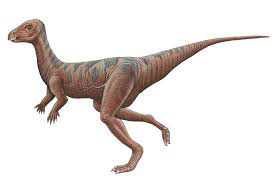Lycorhinus (phonetically spelled as Ly-koe-rhy-nuss) is an Angustidens and Parvidens type species named by Sidney H. Haughton in 1924. The classification of the species is as follows: Chordata – Reptilia – Dinosauria – Ornithischia – Heterodontosauridae – Heterodontosaurinae

The size of the Lycorhinus is estimated to be about 1.2 meters long. Their diet is estimated to be either herbivorous or omnivorous. The known location is the Elliot Formation in the Cape Province in South Africa. They existed during the Hettangian to the Sinemurian period of the Jurassic. The fossil material consists of partial skulls, dentaries and maxillae.
The generic name of the Lycorhinus means "wolf snout" as it was at first misidentified as a cynodont, and the specific descriptor means "constricted tooth". Lycorhinus is a genus of heterodontosaurid ornithischian dinosaur hailing from the Early Jurassic (Hettangian to Sinemurian ages) strata of the Elliot Formation located in the Cape Province, South Africa. Three other species of Lycorhinus have been named. Lycorhinus parvidens was created by Robert Broom and Lycorhinus tucki by Richard Anthony Thulborn in 1970 renaming Heterodontosaurus tucki,but these have failed to find recognition. Lycorhinus consors, named by Thulborn in 1974, was renamed Abrictosaurus by James Hopson in 1975. Lycorhinus, including the remains described by Gow in 1975 as Lanasaurus, is a small herbivorous dinosaur of 47 inches in length, despite the long canines it sported in its jaws. Because of this typical characteristic the Angustidens species is very clearly allied to Heterodontosaurus. Thulborn in 1971 created a separate Lycorhinidae but this group was equated with Heterodontosauridae by Peter Galton in 1972. Only in 1962, Alfred Walter Crompton recognised it was an ornithischian dinosaur.
| Name: | Lycorhinus (Wolf snout). |
| Phonetic: | Ly-koe-rhy-nuss. |
| Fossil representation: | Partial skulls,dentaries and teeth.. |